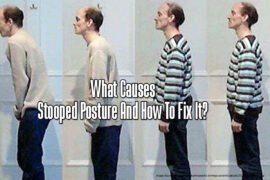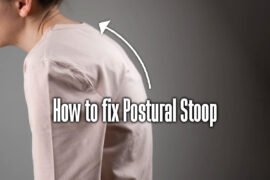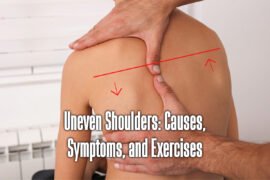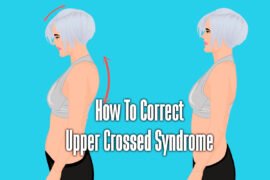Upper Back Stretches are an important exercise in relieving Back Pain, and there are various exercises to get relief from back pain. As you spend a great deal of time slouched in front of your computer at work, chances are that you’ve experienced tension and stiffness in your upper back. Despite regular exercise, it can be almost impossible to dodge the stiff neckedness that comes with today’s working atmosphere. Are you experiencing any form of back or shoulder pain? It is the result of continuously sitting in an unhealthy posture for extended periods. When muscles become tense and tight, they can constrict blood flow to the brain, causing a negative impact on your mood, focus, and cognitive abilities.
This post dives into the details of how you can loosen your muscles and reduce pain. You will discover straightforward techniques and stretches of myofascial release that target your upper back muscles, enabling you to counteract the tension in your body, improve your posture, and feel better both day and night.
Uncovering the Cause of Upper Back Tension: What’s Really Going On?
Table of Contents
Upper back tension can be caused by several factors, including poor posture, muscle imbalances, stress, and repetitive strain. Poor posture, such as slouching or hunching over, can place excessive stress on the muscles and ligaments in the upper back, leading to tension and discomfort. Muscle imbalances, where certain muscles are stronger or tighter than others, can also contribute to tension in the upper back. Additionally, stress and emotional factors can manifest physically as tension in the muscles. Finally, activities that involve repetitive movements or prolonged periods of sitting can strain the muscles in the upper back, leading to tension and pain. Identifying and addressing these underlying causes through posture correction, stretching and strengthening exercises, stress management techniques, and ergonomic adjustments can help alleviate upper back tension.
Learn the Best Ways to Stretch and Strengthen Your Upper Back Muscles
Now that you know the targeted muscles, let’s work on relieving tension and discomfort one muscle group at a time. Through myofascial release and stretching, these exercises help lengthen tight muscles and effectively relax knots in muscle fibers. To experience the benefits of myofascial release, tools such as massage balls and foam rollers are essential. By loosening the fascia of your muscles, these treatments can provide relief from muscle pain and aid in preventing bones from rubbing against each other. Moreover, they help lubricate the muscles to keep them functioning optimally.
If you’re unfamiliar with stretching and myofascial release, it’s best to receive professional guidance. Before attempting these upper back stretches, those individuals with shoulder or neck injuries must confer with a medical specialist. Now, we will demonstrate release and stretch techniques for the upper back muscles that were just discussed.
Shoulder Blade Squeeze
Stand or sit with your back straight and shoulders relaxed. Squeeze your shoulder blades together as if you’re trying to hold a pencil between them. Hold for 5-10 seconds and repeat 5-10 times.
Chest Stretch
Stand with your feet shoulder-width apart. Interlace your fingers behind your back and gently lift your arms upward while squeezing your shoulder blades together. Hold for 20-30 seconds and repeat 2-3 times.
Cat-Camel Stretch
Start on your hands and knees in a tabletop position. Slowly arch your back upward, dropping your head down (cat pose). Then, reverse the movement by dropping your belly towards the floor, lifting your head up, and arching your back (camel pose). Repeat this flow for 1-2 minutes.
Thoracic Extension Stretch
Sit on the floor with your legs extended in front of you. Place a foam roller or rolled-up towel horizontally behind you at the level of your shoulder blades. Lean back onto the roller and support your head with your hands. Slowly extend your upper back over the roller and hold for 20-30 seconds. Repeat 2-3 times.
Deltoids Stretch
To restore the full range of motion in your deltoids, a massage ball against the wall can be used to effectively target all areas – from front and sides to back. Position your body sideways, facing a wall, and use circular motions to knead your lateral deltoids. To optimally target your anterior deltoids, stand directly in front of the wall; for the posterior deltoids, face away from it.
Stop Upper Body Pain and Tightness Before it Starts: Strategies for Prevention
Although stretching can be beneficial in providing relief for upper back pain, an even better way to ensure its absence is by removing the root causes of it. Here are some useful strategies to keep your upper body free from stiffness and discomfort:
- To protect yourself from upper body stiffness and pain, it’s best to avoid sitting in awkward postures for long periods.
- To maintain circulation and prevent stiffening of the back muscles, taking regular breaks between 20-30 minutes is suggested when sitting at a desk. During these intervals, be sure to move around or stretch!
- Constantly maintain an upright posture that maintains the natural curvature of your spine; avoid positions, especially for extended amounts of time, which cause you to hunch forward and round your shoulders.
- If you have trouble maintaining good posture while seated, a standing desk may be your best solution.
- Enhance your posture by sitting at a desk and performing shoulder rolls, first raising them up, then rolling back and down.
- Open your chest and lift it up while engaging your abdominal muscles to stabilize the back.
- Rather than relying on your regular desk chair, consider experimenting with a stability ball or kneeling chair. These options can help you maintain good posture and break the habit of slouching.
- Good posture is essential in preventing painful back issues, so it’s important to be mindful and observe your stance when you’re on your feet.
- To avoid strain on your arms during prolonged periods of activity, like keyboarding or operating a vehicle, be sure to relax your shoulders downwards.
- Don’t let their tension creep up your back, creating tightness in your lats and shoulders.
FAQs
Q1. Why should I do upper back stretches for back pain relief?
Upper back stretches help to relieve tension and improve flexibility in the muscles of the upper back, reducing back pain and promoting better posture.
Q2. How often should I do upper back stretches?
It is recommended to perform upper back stretches at least two to three times per week to maintain flexibility and alleviate back pain. However, consult with a healthcare professional for personalized advice.
Q3. Can upper back stretches be done by anyone?
Upper back stretches are generally safe for most individuals. However, it is advisable to consult with a healthcare professional, especially if you have an existing medical condition or are experiencing severe back pain.
Q4. Are there any specific upper back stretches that I should try?
Yes, there are several effective upper back stretches you can try, such as the shoulder blade squeeze, upper back extension, and doorway stretch. These stretches target different muscles in the upper back to provide relief.
Q5. Can I do upper back stretches at work?
Yes, many upper back stretches can be done at your desk or workplace. Simple stretches like shoulder rolls, neck stretches, and seated twists can help relieve tension and promote better posture during long hours of sitting.
Q6. How long should I hold each upper back stretch?
It is generally recommended to hold each stretch for 15 to 30 seconds, gradually increasing the duration as your flexibility improves. Remember to breathe deeply and relax during each stretch.
Q7. Are there any precautions I should take while doing upper back stretches?
Yes, it is important to listen to your body and avoid overstretching or forcing any movement. If you experience pain or discomfort during a stretch, stop immediately. Additionally, warm up your muscles with light activity before stretching.
Q8. Can upper back stretches alone cure my back pain?
Upper back stretches can help alleviate back pain, but they may not be a standalone solution. It is essential to maintain overall physical fitness, practice good posture, and consider a comprehensive approach to managing back pain, including exercise, ergonomic adjustments, and professional guidance if needed.
Q9. How long does it take to experience relief from back pain through upper back stretches?
The timeframe for experiencing relief from back pain through upper back stretches can vary depending on individual factors such as the severity of the pain, consistency of stretching, and underlying causes. Some individuals may experience immediate relief, while others may take several weeks or more to notice improvement.
Q10. Are there any other methods I can combine with upper back stretches for better results?
Yes, combining upper back stretches with other practices such as regular exercise, strengthening exercises, stress management techniques, and ergonomic adjustments can enhance the effectiveness of your back pain relief efforts. Consult with a healthcare professional for personalized recommendations.
Summary
Dedicating yourself to these exercises and tips daily will yield visible results in the way your upper back feels within a week or two. Yet, there is no denying the immediate surge in energy and improved mood that comes from taking a few moments to stretch. Releasing and stretching tense muscles in your upper back can be beneficial for promoting good posture, which is key to maintaining a healthy spine. Not only will your posture improve, but you should also feel less tension and stiffness in your body. If none of the above upper back stretches to aid in alleviating your discomfort, then it is recommended to seek professional medical attention.








